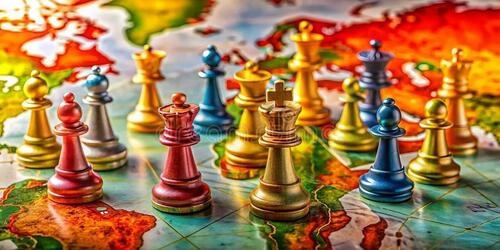The
Via Gold and Geopolitics Substack,
Foreword
I initially planned to write this as a multi-part series, but ultimately decided to consolidate everything into one article as breaking it up wouldn’t do justice to the topic. There’s a lot to unpack when delving into the ongoing societal changes, and I feel like I’ve only scratched the surface. Even with a word count exceeding 6000 words and spending close to 10 full waking days refining it, the magnitude of what we’re witnessing seems almost too vast to capture in a single piece.
The Fourth Turning doesn’t gradually reveal itself—it crashes over you all at once when you finally start to see the pattern. Writing this piece felt like trying to grasp sand in my hands; every effort to contain one aspect of the transformation led to three more slipping through my fingers.
What you’re about to read is my best attempt to outline the outlines of something far greater than any individual could fully comprehend.
The same boiling water that softens the potato hardens the egg.
— Roald Dahl
We’re all in the same boiling water now—the Fourth Turning’s Crisis that began with Lehman Brothers’ collapse in 2008—but whether we emerge hardened or dissolved depends entirely on what we’re made of. We’re now deep in the Fourth Turning, the winter of this historical cycle, and if you think the past few years have been chaotic?
You ain’t seen nothing yet!
History doesn’t move in straight lines. It breathes, it pulses, it turns through seasons as predictable as winter following autumn. William Strauss and Neil Howe discovered this pattern in 1997. Like clockwork, every 80 years or so – a human lifetime, America faces an existential crisis that threatens to tear apart everything we thought permanent. We’ve been through this three times before, and we’re going through it again right now.

In 1997, Strauss and Howe predicted that around 2005, some spark would ignite a Crisis mood. They suggested it might be “as ominous as a financial crash, as ordinary as a national election, or as trivial as a Tea Party”. They hit the nail on the head. The 2008 financial crisis wasn’t just another recession—it was the moment the post-World War II global order began its death spiral. Lehman Brothers’ collapse on September 15, 2008, marked more than a bank failure; it marked the beginning of the end of trust in the system itself.
I started following these markets around 2007, and what unfolded after that specific collapse was unprecedented. The Federal Reserve’s balance sheet ballooned from $900 billion to $4 trillion in a matter of years, then to $9 trillion during COVID. The national debt, which stood at $10 trillion in 2008, has now reached $37 trillion as of August 2025. We didn’t solve the crisis—we papered it over with printed money and kicked the can down the road. We didn’t solve the problem—we made it exponentially worse. As someone who tracks gold markets, I can tell you with increasing clarity: the people who truly understand money are quietly converting their paper promises into something that can’t be printed.

The response to 2008 revealed a crucial aspect: our institutions no longer operated as intended. The Federal Reserve, originally established as a lender of last resort, became the market itself. Banks that should have failed were deemed “too big to fail”. Capitalism’s fundamental principle—that poor decisions lead to bankruptcy—was put on hold for the connected elite while being strictly enforced on everyone else. The very individuals who caused the crisis not only evaded punishment but were rewarded with bonuses funded by taxpayer bailouts. The social contract didn’t just fray; it snapped.
What most people didn’t grasp then—and many still don’t realize now—is that 2008 never truly ended. Each intervention created larger distortions requiring more significant interventions. Zero interest rates resulted in asset bubbles. Quantitative easing led to an explosion in wealth inequality. Each “solution” worsens the underlying problem: a system that could only survive through ever-increasing debt monetization. The music has stopped, but the Fed keeps the party going by cranking up the volume until everyone is deaf.
The ripple effects spread globally. European banks, laden with toxic American mortgage securities, needed massive bailouts. This was followed by the European debt crisis, nearly destroying the euro. China, fearful of a global depression, initiated the most massive credit expansion in history, constructing ghost cities and redundant infrastructure. Every major economy became addicted to monetary heroin, and seventeen years later, we’re still injecting.
However, the financial crisis merely acted as the catalyst. What makes this a Fourth Turning isn’t the immediate cause but the comprehensive breakdown that ensues. Look around. Every institution that Americans once trusted—government, media, academia, medicine, law enforcement, intelligence agencies—has suffered catastrophic reputational collapse. When the CDC alters its narrative for the fifth time, when the FBI raids a former president, when the legitimacy of the Supreme Court is openly questioned, it’s not merely political friction. It’s the complete unraveling of institutional authority.

This Fourth Turning differs fundamentally from all previous ones due to the role of technology. We aren’t fighting with muskets or tanks—we’re battling with algorithms, narratives, and digital currencies. The battlefield isn’t Gettysburg or Normandy; it’s your smartphone screen, your social media feed, your digital wallet.
Previous Fourth Turnings required mass mobilization of physical bodies. Men marched off to war, women contributed to factories, everyone bought war bonds. Physical presence was crucial. However, our Fourth Turning is being fought in the realm of information and perception. When you can’t trust any information source, when deepfakes make seeing no longer believing, when AI can generate limitless propaganda at no extra cost, how do you discern what you’re fighting for or against? The fog of war has evolved into the fog of everything.

Consider the extensive surveillance apparatus that has emerged since 2008. Edward Snowden’s revelations in 2013 exposed the NSA’s collection of every email, every text, every call. However, that was just the tip of the iceberg. Today, we have AI-powered behavioral prediction, social credit systems, and facial recognition networks. China leads the way with 700 million surveillance cameras—more than half the world’s total—but Western “democracies” aren’t far behind. London boasts more cameras per capita than Beijing. San Francisco utilizes the same facial recognition technology as Shanghai.
The COVID-19 pandemic accelerated this technological authoritarianism by decades. Digital vaccine passports normalized the concept that government permission is required to enter a restaurant. Contact tracing apps conditioned us to accept constant location monitoring. QR codes rendered every movement trackable. What would have taken a generation to implement gradually was achieved in months under the guise of “public health”. The ratchet only turns one way—powers acquired during a crisis are never voluntarily relinquished.

Consider the Central Bank Digital Currency (CBDC) agenda advancing globally while most people remain blissfully unaware. This isn’t just about digitizing money—it’s about making money programmable, controllable, censorable. The Federal Reserve, Bank of England, and European Central Bank are all developing CBDCs, following China’s lead with the digital yuan. Envision a world where your ability to purchase gasoline hinges on your carbon credit score, where your grocery shopping is limited by your BMI, where your savings can be “expired” to induce spending. Money that cannot be utilized for unauthorized purchases, that can be frozen instantly if you express dissenting views.
This isn’t a figment of the imagination—China is already implementing it. Europe is initiating trials. The Federal Reserve is “researching” it.
This is the ultimate fusion of monetary and social control.
Bitcoin emerged from the ashes of the 2008 crisis with a message embedded in its genesis block: “Chancellor on the brink of second bailout for banks”. The cypherpunks who developed it—whether Satoshi was an individual or a team—understood that monetary sovereignty necessitated technological sovereignty. Yet here’s the uncomfortable question: did we outplay them, or did they outplay us? Bitcoin’s transparent blockchain ensures that every transaction remains traceable forever. The NSA’s 1996 paper “How to Make a Mint” outlined a system remarkably similar to Bitcoin. The CIA engaged with Gavin Andresen, Bitcoin’s lead developer, in 2011. Was Bitcoin genuine resistance or the perfect trap—convincing libertarians to establish their own financial panopticon?

The promise was decentralization, but the reality is becoming increasingly centralized. A handful of mining pools control Bitcoin’s hash rate. A few exchanges dominate most trading volume. BlackRock and other institutions now hold significant ownership through ETFs. The rebels who believed they were constructing an alternative to Wall Street may have inadvertently built Wall Street 2.0. With enhanced surveillance.
Every Fourth Turning involves a monetary reset. The Revolution gave us the Constitution’s gold and silver clause. The Civil War introduced greenbacks and the National Banking System. The Depression/WWII era terminated the gold standard domestically and established Bretton Woods. The impending reset will likely be even more striking.
The figures are so massive that they’ve lost all significance. The U.S. national debt has surged to $37 trillion as of August 2025. Unfunded liabilities—Social Security, Medicare, government pensions—surpass $200 trillion. The Federal Reserve maintains over $1 trillion in unrealized losses. Commercial banks are holding $600 billion in underwater securities. We aren’t on the brink of insolvency. We’re already there. Just one repricing away from systemic collapse. And everyone in finance is aware of it. The only query is whether it will unfold gradually (inflation), abruptly (default), or systematically (CBDC rollout).
My money, literally, is on “all of the above”.

While Americans engage in debates over pronouns and vaccines, the rest of the world is not standing still. The real story of the Fourth Turning isn’t solely about America—it’s about the conclusion of the American Century and the emergence of something new. The unipolar era that commenced with the collapse of the Soviet Union in 1991 has ended. We aren’t transitioning to a new order but to disorder—multiple competing power centers with conflicting worldviews and no dominant power capable of enforcing rules.
Russia and China’s “no limits” partnership, announced on February 4, 2022, just before the Ukraine conflict, represents the most significant geopolitical realignment since the Molotov-Ribbentrop Pact. Unlike that cynical pact between natural adversaries, this reflects genuine strategic convergence.
Let that sink in.
The two most significant threats to American hegemony have decided that they are stronger together than apart. China requires Russian resources and military technology. Russia requires Chinese markets and manufacturing. Both need to challenge American hegemony. Their combined nuclear arsenals, industrial capacity, and geographical positioning render them essentially unsanctionable and uncontrollable. While we’ve been consumed by internal divisions, they’ve been accumulating gold, constructing alternative payment systems, and shaping a parallel world order that doesn’t rely on dollars or SWIFT.
I’ve referred to this as “water finding a way”—capital, trade, and power circumventing obstacles like sanctions and discovering new channels. The West sanctions Russia, so Russia offers oil to India and China at a discount. We freeze Russian reserves, so others begin to question the safety of their dollars. We weaponize SWIFT, so alternative payment systems are being developed. Every action triggers an equal and opposite reaction, and we’re too arrogant to see that we’re hastening our own replacement.
However, the most devastating loss isn’t financial or military—it’s moral. The West established its post-WWII hegemony not just on military might and economic power but on moral authority. We are the “good guys” who defeated fascism, rebuilt Europe, and championed democracy and human rights. That moral high ground has been shattered, destroyed by our own hypocrisy. When we preach about sovereignty while expanding NATO to Russia’s borders despite assurances to the contrary, when we invoke the “rules-based order” while ignoring international law when convenient, when we impose sanctions on countries for actions we ourselves commit—the world sees through the facade more and more.
Consider Ukraine. We frame it as democracy versus autocracy, good versus evil. But Russia has legitimate security concerns that we’ve willfully disregarded for decades. How would America react if China formed a military alliance with Mexico and stationed missiles in Tijuana? We know exactly how—we nearly started nuclear war over Soviet missiles in Cuba. Yet we expect Russia to accept NATO expansion to its borders as routine. The West could have ensured Ukrainian neutrality and avoided this war altogether. Instead, we exploited Ukraine as a proxy to weaken Russia, but it’s Ukraine that’s bearing the brunt. Hundreds of thousands dead. For what? So Victoria Nuland could add another regime change to her resume?
Or examine Gaza. Israel is systematically eradicating an entire population—bombing hospitals, schools, refugee camps, killing journalists, aid workers, children by the thousands. The International Court of Justice is examining genocide allegations. They issued arrest warrants. Yet the same Western leaders who condemn Russian war crimes supply Israel with weapons and diplomatic support for atrocities that defy belief.
When you witness children being intentionally starved and bombed while your government justifies it as “self-defense,” something fundamental shatters in your worldview. The system reveals itself not just as flawed but actively malevolent.
This moral bankruptcy accelerates the institutional collapse of the Fourth Turning

